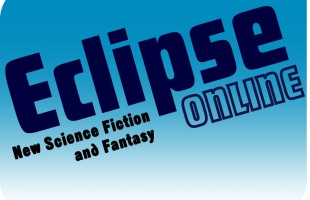 Eclipse Online #1, October 2012
Eclipse Online #1, October 2012
Reviewed by Matthew Nadelhaft
New periodical Eclipse Online is offering up two stories a month, and this month two novellas, making for a more substantial reading experience than many online periodicals provide. Starting off with a bang, the first issue contains long works by established names Christopher Rowe and K. J. Parker.
The last time I had the pleasure of reviewing Christopher Rowe was when Small Beer Press published his chapbook Bittersweet Creek and Other Stories. I was impressed then, and I’m impressed now. His story “The Contrary Gardener” is, among other things, a fabulous literary pun. It isn’t just the title that alludes to John Le Carré; Rowe puts the pun in the heart of the story by plunging his protagonist, gardener Kay Lynne, into political manipulations. But this isn’t an espionage story: I did say “The Contrary Gardener” was a literary pun among other things, and it’s those other things that are most interesting.
Rowe may have invented a new sub-genre with this story: rural steampunk. It takes place on the outskirts of a large city (presumably Louisville), among characters preoccupied with their vegetable gardens, horse racing, and the influx of tourists attending the Derby-week hot-air balloon show. There are also talking robot bus drivers, neon signs projected onto the skyscrapers, hints of an American patriotism of wastefulness, and evidence that vegetables are being grown as ammunition for some long-running, far-flung war.
It’s details like these that make the story, but at times they threaten to overwhelm the story. While Kay Lynne’s relationship with her father is superbly painted and both characters are believable and full, the plot itself could be expressed in a much shorter work. The political machinations hinted at in the title and realized towards the end of the story are, in a way, of less importance and interest than the characters and the many enigmas of Rowe’s well-cultivated world.
The same issues surround K. J. Parker’s “One Little Room an Everywhere,” a tale of magic and art set in an unknown time and world of religion and iconography. The narrator, who gives himself the name Epistemius (but not until page eleven), has washed out of school – the Studium – in a society dedicated to the worship of “the Invincible Sun.” With few options, he embarks on a career in religious iconography, which he produces by magic. The magical theory in this story, by the way, is fascinating and unique and could easily form the background for a novel or even a series.
But magic wasn’t meant to be used in the creation of religious iconography, and Epistemius’s masterworks bring terrible misfortune to their owners even as they make him wealthy and famed. He isn’t to blame, he takes pains to tell the reader – he didn’t know.
That knowledge is the crux of this story might be gleaned from the assumed name of the main character, derived from epistemology, the philosophy of what and how we know. There’s a tension between forms of knowledge in this story, expressed in part by the incredibly formal rules for constructing iconography and delimiting its subjects. Epistemius follows these rules in that his finished works adhere to them, even though the process by which he produces his artworks is akin to dreaming them into existence and involves pure fancy and no craftsmanship. How often have you dreamed of possessing something only to know that, upon wakening, it will disappear? I remember, as a youth, trying to discover, in my dreams, a way to keep hold of whatever it was I’d found when I woke.
Epistemius does just that, through an arcane technique long forbidden. Is it the price paid for the use of an outlawed practice that leads to the calamities surrounding the artworks? Epistemius’s investigations only lead to more questions when he learns a shocking truth – or non-truth – about the technique he thought he stole. Perhaps the disasters deriving from Epistemius’s talent are, like that which Samuel Delany posits in Dhalgren, the result of a collapse in structure, the intrusion of absolute creativity into a realm of absolute constraint.
In fact, the question of structure, creativity, and discipline is the heart of the novella form itself. Neither a short story nor a novel, the novella has to take care to be its own being and not aspire to being either of the other forms. How authors handle this dilemma is an intense and instructive wire-walking act. One can create a setting rich enough to be the story itself, as Rowe does, or write a story big enough to demand expansion out of the short story form, as Parker has done here. Both are fascinating to read.